Abstract
The reduction of fossil CO2 emissions from key relevant industrial processes represents an important environmental challenge to be considered. To enable large-scale deployment of low carbon technologies, a significant research and development effort is required to optimize the CO2 capture systems. This work assesses various hybrid solvent-membrane configurations for post-combustion decarbonization of coal-based super-critical power plants. As an illustrative chemical solvent, Methyl-Di-Ethanol-Amine was assessed. Various membrane unit locations were assessed (e.g., top absorber, before absorber using either compressor or vacuum pump). All investigated designs have a 1000 MW net power output with a 90% decarbonization ratio. Benchmark concepts with and without carbon capture using either reactive gas-liquid absorption or membrane separation technology were also evaluated to have a comparative assessment. Relevant evaluation tools (e.g., modeling, simulation, validation, thermal integration, etc.) were employed to assess the plant performance indicators. The integrated evaluation shows that one hybrid solvent-membrane configuration (membrane unit located at the top of absorption column) performs better in terms of increasing the overall net plant efficiency than the membrane-only case (by about 1.8 net percentage points). In addition, the purity of captured CO2 stream is higher for hybrid concepts than for membranes (99.9% vs. 96.3%). On the other hand, the chemical scrubbing concept has superior net energy efficiency than investigated hybrid configurations (by about 1.5–3.7 net percentage points).
1. Introduction
Reduction of fossil CO2 emissions from relevant large-scale industrial applications represents a significant global environmental challenge for the short to medium term to actively combat global warming and climate change [1]. This important environmental task can be achieved by various technical methods for instance [2]: boosting the renewable sources of energy, increasing the energy efficiency of both production & utilization steps, large-scale implementation of low-carbon solutions, etc. To underline, the crucial important element of tackling global warming, the European Union (EU) launched The Green Deal—an ambitious program aimed to make the European continent climate neutral by half of this century [3]. Furthermore, the “Fit for 55” legislative act proposes at least a 55% emission reduction target for the whole EU block by 2030. In terms of decarbonization options, the Carbon Capture, Utilization, and Storage (CCUS) systems are foreseen to take an important role. Along this line, an important global innovation effort is required for the identification of the most efficient and economic routes for decarbonization [4]. For instance, in the case of Romania (of which electricity is generated about 30% from coal/lignite and about 15% from natural gas), the large-scale implementation of CCUS technology is considered a strategic element for the medium term to comply with new EU regulations in term of energy and climate.
Currently, the reactive absorption using alkanolamines represents the most commercial and technological mature option for CO2 capture (being used for decades in the chemical industry for gas decarbonization) [5]. This decarbonization method could be successfully employed in pre- and post-combustion configurations. The most important drawback of amine-based CO2 capture represents the energy consumption for solvent regeneration (which is typically about 3 GJ/t CO2). Therefore, improved chemical scrubbing systems are required to be developed for CO2 capture [6]. On the other hand, the membrane technology starts to find potential applications in CO2 capture based on its advantages (e.g., low complexity and easy scale-up, reduced energy consumption, environmentally friendliness, etc.) [7]. One of the most important drawbacks of membrane technology used for CO2 capture are: higher ancillary power consumption to overcome pressure drop across the membrane and lower capture CO2 purity. As in the case of chemical absorption, further research is needed to overcome these limitations.
The purpose of this work is to compare various hybrid solvent-membrane configurations for post-combustion CO2 capture to be used in fuel-based super-critical power generation. As an illustrative example, a 1000 MW net output power plant with a 90% decarbonization yield was assessed. Methyl-Di-Ethanol-Amine (MDEA) is selected as solvent [8] and polymeric-based material was chosen for membrane construction [9]. In terms of hybrid process configurations, various cases were considered, based on the membrane location [10], e.g., placing the membrane unit before the gas-liquid absorption unit using either a compressor or a vacuum pump for flue gases, placing the membrane unit at the top of the absorber with recirculation of the permeate flow. These hybrid solvent-membrane configurations were evaluated in comparison to the benchmark cases which use either only chemical scrubbing or only membrane for decarbonization. A non-decarbonized case is investigated to evaluate the decarbonization energy penalty. The most important key novelty elements of this work in comparison to the literature sources are the following: assessing MDEA solvent in hybrid systems in comparison to the literature sources (which mostly use mono-ethanol-amine or piperazine [11,12]), different process layouts (as presented in Section 2 of the paper) in comparison to literature sources [13], utilization of wide process assessment tools (e.g., modeling and simulation, validation, thermal integration, overall process evaluation, etc.) as well as an integrated evaluation methodology including benchmark cases and definition of global plant performance indexes.
2. Hybrid Solvent-Membrane Post-Combustion CO2 Capture Configurations
A conventional reactive absorption-desorption cycle for CO2 capture (considered as a benchmark concept for the hybrid cases) has the conceptual layout as presented in Figure 1 [14]. As can be noticed, the chemical solvent is contacted in the absorption column with flue gases, CO2 is chemically bound with the solvent (MDEA in this analysis) as presented in the next reaction:
CO2 + MDEA + H2O ↔ MDEAH+ + HCO3−
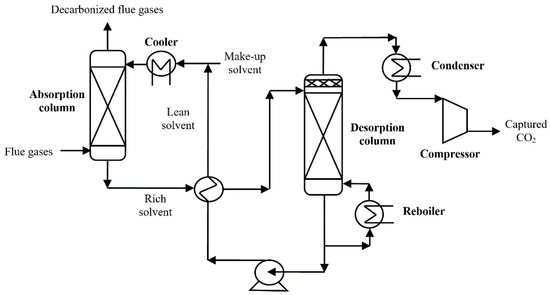
Figure 1.
CO2 capture plant by chemical absorption-desorption cycle (benchmark).
After absorption, the rich loaded solvent is subject to a desorption stage where heat is used to reverse the process (CO2 separation simultaneously with solvent regeneration). The heat duty for solvent regeneration is serviced by low-pressure steam extracted from the steam cycle, therefore reducing energy efficiency. As discussed further, thermal duty for solvent regeneration is a key element. The desorbed CO2 is furthermore dried in a Tri-Ethylene-Glycol (TEG) unit and compress to about 120 bar before being sent to storage/utilization. The regenerated solvent stream is sent back to the absorber.
Another benchmark system to be compared to hybrid solvent-membrane configurations is a three-stage membrane process for CO2 capture as illustrated in Figure 2. A three-stage membrane process is required to achieve both the targeted 90% carbon capture rate as well as min. 95% purity of captured CO2 stream [15]. As can be observed, the flue gases have to be compressed before any membrane unit to provide enough driving force for CO2 separation. As discussed further, power consumption represents an important element of any membrane unit for CO2 capture.

Figure 2.
CO2 capture plant by three-stage membrane unit (benchmark).
In respect to the hybrid solvent-membrane configurations analyzed in this paper, the following systems were assessed:
- -
- Pre-concentration membrane unit using vacuum pump located before chemical scrubbing unit (see Figure 3);
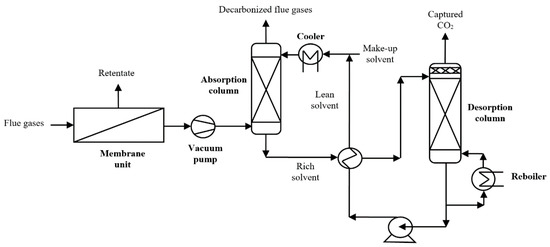 Figure 3. Layout of hybrid system with pre-concentration membrane unit using vacuum pump.
Figure 3. Layout of hybrid system with pre-concentration membrane unit using vacuum pump. - -
- Pre-concentration membrane unit using compressor located before chemical scrubbing unit (see Figure 4);
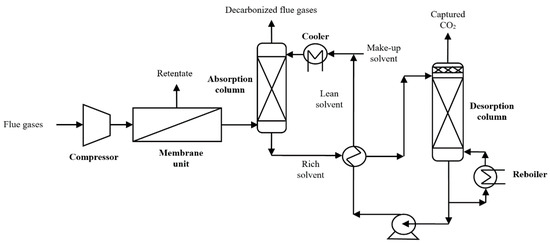 Figure 4. Layout of hybrid system with pre-concentration membrane unit using compressor.
Figure 4. Layout of hybrid system with pre-concentration membrane unit using compressor. - -
- The membrane unit is located at the top of the absorption column (see Figure 5).
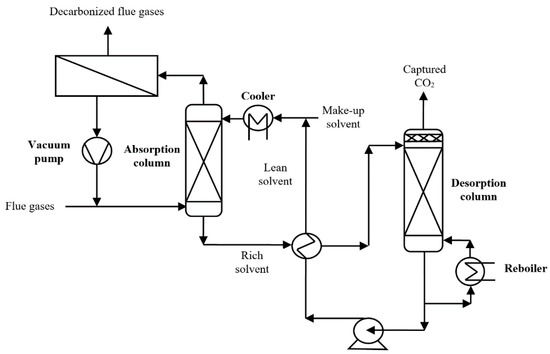 Figure 5. Layout of hybrid system with membrane unit at the top of absorption column.
Figure 5. Layout of hybrid system with membrane unit at the top of absorption column.
In respect to the ancillary energy consumption of the CO2 capture plant, the hybrid systems require both thermal duty for solvent regeneration (low-pressure steam is consumed at the bottom of the desorber) as well as power for the compressor/vacuum pump (membrane unit).
3. Decarbonized Coal-Based Super-Critical Power Plants, Main Design Characteristics and Assessment Methodology
As a targeted industrial process to be decarbonized by hybrid solvent-membrane systems, a 1000 MW net output coal power plant was considered. The decarbonization yield is fixed to 90% similar to most of the CCS projects [16]. The design of decarbonized coal-based power plant is shown in Figure 6 [17]. As can be noticed, the flue gases resulted after coal combustion is subject to particulate matter, NOx, and SOx removal prior to CO2 capture either by chemical scrubbing, membrane, or hybrid systems.
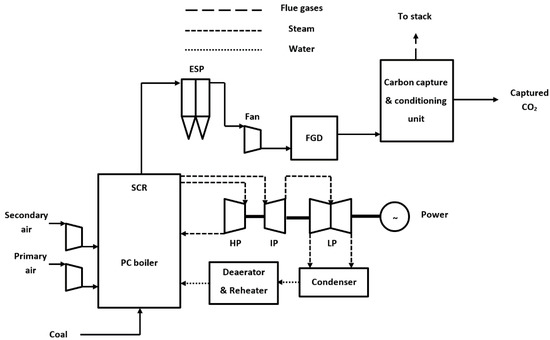
Figure 6.
Layout of decarbonized coal-based super-critical power plant.
Table 1 exhibits the most important technical assumptions of investigated power plants with and without carbon capture.

Table 1.
Main technical assumptions of evaluated power plants.
All investigated concepts were modeled and simulated using ChemCAD [22]. Then the main mass and energy balances are furthermore employed to calculate the global performance indicators. The following key performance indicators were evaluated and compared:
- -
- Net and gross power plant efficiencies (ηnet/ηgross) were calculated as ratios between the net/gross power outputs (Wnet/Wgross) and coal thermal input (QFuel) as follow:
- -
- Ancillary power consumption was calculated as a sum of all electricity consumptions of various plant sub-systems:
- -
- Carbon capture rate (CCR) was calculated as a percentage of feedstock (coal) carbon to be captured:
- -
- Specific CO2 emission of the power plant (SECO2) was calculated as the ratio of emitted CO2 mass flow (FEmitted CO2) and net power output (Wnet):
- -
- Specific energy consumption for CO2 capture (SPECCA) was calculated based on net efficiencies and specific carbon emissions of both designs with and without carbon capture by the following equation [23]:
- -
- Heat duty for solvent regeneration was calculated considering the thermal energy in the reboiler divided by the mass flow of captured CO2 stream:
- -
- Ancillary power consumption for membrane separation was calculated considering the power consumption for compressor/vacuum pump of membrane unit divided by the mass flow of captured CO2 stream:
4. Results and Discussion
The following coal-based power plant concepts were evaluated:
- Case 1.a—Super-critical power plant without carbon capture (benchmark);
- Case 1.b—Decarbonized power plant with chemical scrubbing (benchmark);
- Case 1.c—Decarbonized power plant with 3-stage membrane unit (benchmark);
- Case 2.a—Decarbonized power plant with a hybrid unit (vacuum pump);
- Case 2.b—Decarbonized power plant with a hybrid unit (compressor);
- Case 2.c—Decarbonized power plant with a hybrid unit (top absorber).
ChemCAD software was used for modeling and simulation of all investigated power plant concepts. The used thermodynamic models were in line with process conditions (involved chemicals, conditions etc.). For most of the units (fuel processing, flue gas treatment, steam production, membrane etc.) Soave-Redlich-Kwong (SRK) was selected. The reactive gas-liquid absorption used a kinetic model and for CO2 drying TEG Dehydration model was employed. Once the simulation was performed, the obtained results were compared against the experimental data in view of validation [24,25,26]. As an illustrative case, Figure 7 presents the comparison of experimental vs. simulation results for chemical scrubbing unit at various solvent loadings (loading range 1: <0.3 mole CO2/mole amine; loading range 2: 0.3–0.4 mole CO2/mole amine; loading range 3: >0.4 mole CO2/mole amine).
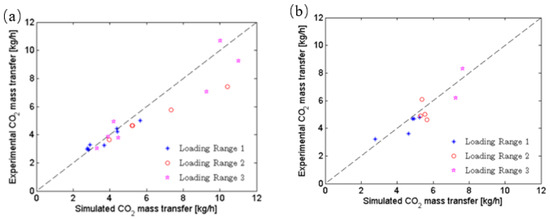
Figure 7.
Comparison of experimental vs. simulation results (a) Validation of absorption process (b) Validation of desorption process.
Furthermore, all investigated plant designs are the subject of in-depth thermal integration analysis in view of energy efficiency optimization [27]. To illustrate the thermal integration analysis, Figure 8 presents the composite curves (hot composite curve—HCC and cold composite curve—CCC) for the MDEA-based chemical scrubbing unit (Case 1.b). One can observe that the quantity of available heat is significantly large (coming mainly from the exothermic reaction heat between CO2 and amine) but the correspondent temperature is close to the ambient one, which means that this heat can only be removed with cooling water without contributing to the global energy efficiency. This aspect represents the most important drawback of chemical scrubbing technology used for CO2 capture in comparison to other decarbonization technologies which operate at higher temperatures (e.g., chemical/calcium looping).
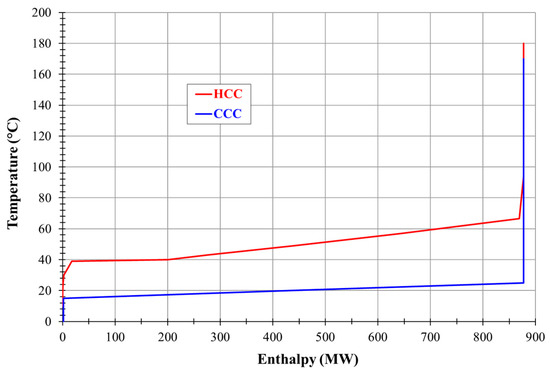
Figure 8.
Thermal integration analysis for MDEA-based CO2 capture unit.
Table 2 presents the global plant performance indexes of the benchmark cases (super-critical power plants with and without CO2 capture based on chemical scrubbing and 3-stage membrane unit).

Table 2.
Global plant performance indexes of benchmark cases.
As can be observed, the introduction of the decarbonization feature (either by reactive gas-liquid absorption or by the membrane) induces a reduction of overall net energy efficiency in comparison to the non-decarbonized cases. This difference between the net power efficiencies represents the CO2 capture energy penalty and it is approximatively 9.3 percentage points for the chemical scrubbing concept (Case 1.b) and 12.2 percentage points for membrane concept (Case 1.c). The specific ancillary energy consumption for the carbon capture unit is about 3 GJ/t for the chemical scrubbing concept (reported as heat consumption) and 273.6 GJ/t for the membrane concept (reported as power consumption). These ancillary energy consumptions for benchmark decarbonized concepts are in line with literature sources [28,29,30]. The SPECCA indicator shows also a lower value for chemical scrubbing in comparison to the membrane concept. As shown, the reactive chemical absorption exhibits improved key performance indicators that the 3-stage membrane concept.
Table 3 presents the global plant performance indexes of the hybrid solvent-membrane cases. As can be observed, for the hybrid configurations the heat duty for solvent regeneration decreases from about 3 GJ/t in the case of only chemical scrubbing concept to about 2.4–2.6 GJ/t. This result is due to the higher CO2 concentration in the flue gas to be decarbonized due to the membrane pre-concentration feature. The ancillary power consumption for membrane units in hybrid configurations is also decreasing compared to the case of the 3-stage membrane concept (64–168 vs. 274 kWh/t). Among various investigated hybrid solvent-membrane configurations, the concept with membrane unit located at the top of the absorber performs better than the other two with pre-concentration membrane and vacuum pump/compressor. For example, the net efficiency of Case 2.c is higher than Cases 2.a and 2.b by about 2.6 points. SPECCA indicator shows also a significantly reduced value for Case 2.c compared to the two-hybrid concepts (3.8 vs. 5.2 MJ/kg). The explanation of these results lays in the fact that Cases 2.a and 2.b requires a significant amount of electricity for flue gas manipulation.

Table 3.
Global plant performance indexes of hybrid cases.
Comparing the hybrid solvent-membrane concepts with benchmark concepts that use either only chemical scrubbing or only three-stage membrane, one can notice that Case 2.c (membrane located at the top of absorption column) performs better than Case 1.c (three-stage membrane unit) for instance in term of increasing global net efficiency (by about 1.8 points). When compared to the chemical scrubbing benchmark concept (Case 1.b), Case 2.c shows reduced net efficiency by about 1.5 points. The membrane pre-concentration concepts (Cases 2.a and 2.b) show lower net energy efficiency than the chemical scrubbing benchmark concept (by about 3.7 points) and the three-stage membrane benchmark concept (by about 0.9 points).
The main explanation for this situation represents the ancillary electricity consumption of the membrane unit. For the chemical scrubbing technology used as the decarbonization method, the ancillary energy consumption is represented by solvent regeneration thermal duty. This thermal duty is covered by steam cycle low-pressure steam thus lowering the electricity production of the LP section of the steam turbine. In the case of membrane technology, the ancillary energy consumption is represented by the electricity consumption of compressors/vacuum pumps and has a higher impact on the global net power efficiency than for chemical gas-liquid absorption technology.
A key element in any carbon capture project represents the purity of captured CO2 stream. As a reference, a proposed captured CO2 quality specification was presented in Table 2 based on relevant references in the field [31]. For the membrane technology, the purity of captured CO2 is even more stringent than for chemical scrubbing considering the fact that lower purity is expected for the permeate stream due to selectivity issues between carbon dioxide and other gaseous species. Table 4 presents the compositions (as volumetric percentages) of captured CO2 streams in all investigated carbon capture concepts (either benchmark or hybrid cases).

Table 4.
Composition of captured CO2 streams.
One can notice that the chemical scrubbing system (either alone or in hybrid configuration) gives a significantly higher CO2 concentration than the three-stage membrane system. This aspect can be explained by the higher selectivity of chemical solvent than membrane for carbon dioxide. For hybrid configurations, the captured CO2 streams have similar purities to the chemical scrubbing benchmark concept considering that the membrane is just a pre-concentrator before the reactive gas-liquid absorption cycle.
5. Conclusions
This work assesses the potential of hybrid solvent-membrane systems to deliver better performance indicators than chemical scrubbing only or membrane technologies for decarbonization of coal-based super-critical power plants. The evaluated plants have a 1000 MW net power output with a 90% carbon capture rate. For comparison purposes, similar power plants with or without carbon capture were used as a benchmark. The benchmark decarbonization technologies were based on reactive gas-liquid absorption and three-stage membrane processes.
Among investigated hybrid concepts, the one with membrane unit located at the top of the absorber (Case 2.c) performs better than the other two with the membrane unit as a pre-concentrator (e.g., improved net energy efficiency by about 2.6 points). As the results show, the hybrid solvent-membrane configurations have lower performance indicators than the chemical absorption (e.g., lower net efficiencies by about 1.1–3.8 percentage points). When compared to membrane technology, the hybrid concept with membrane unit located at the top of the absorption column has better performance e.g., 1.8 net energy efficiency percentage points higher. The hybrid systems show higher purity of captured CO2 stream in comparison to the membrane-only concept (99.9% vs. 96.3%). As relevant future development directions, the improvement of membrane performance is an important element to consider.
Author Contributions
Conceptualization, C.-C.C., L.P., A.-M.C. and C.D.; methodology, C.-C.C. and A.-M.C.; software, C.-C.C. and L.P.; validation, A.-M.C. and C.D.; formal analysis, C.-C.C., L.P., and A.-M.C.; investigation, L.P. and A.-M.C.; resources, C.-C.C. and C.D.; data curation, C.-C.C. and C.D.; writing—original draft preparation, C.-C.C., L.P., A.-M.C. and C.D.; writing—review and editing, C.-C.C.; visualization, L.P. and A.-M.C.; supervision, C.-C.C. and C.D.; project administration, C.-C.C. and C.D.; funding acquisition, C.-C.C. All authors have read and agreed to the published version of the manuscript.
Funding
The research leading to these results has received funding from the NO Grants 2014—2021, under project contract no. 13/2020 and a grant of the Ministry of Research, Innovation and Digitization, CNCS/CCCDI—UEFISCDI, project number PN-III-P4-ID-PCE-2020-0632, within PNCDI III.
Institutional Review Board Statement
Not applicable.
Informed Consent Statement
Not applicable.
Data Availability Statement
The data presented in this study are available on request from the corresponding author. The data are not publicly available due to privacy reasons.
Conflicts of Interest
The authors declare no conflict of interest.
References
- Zheng, X.; Streimikiene, D.; Balezentis, T.; Mardani, A.; Cavallaro, F.; Liao, H. A review of greenhouse gas emission profiles, dynamics, and climate change mitigation efforts across the key climate change players. J. Clean. Prod. 2019, 234, 1113–1133. [Google Scholar] [CrossRef]
- Rissman, J.; Bataille, C.; Masanet, E.; Aden, N.; Morrow, W.R.; Zhou, N.; Elliott, N.; Dell, R.; Heeren, N.; Huckestein, B.; et al. Technologies and policies to decarbonize global industry: Review and assessment of mitigation drivers through 2070. Appl. Energy 2020, 266, 114848. [Google Scholar] [CrossRef]
- European Commission. The European Green Deal; COM (2019) 640 final; European Commission: Brussels, Belgium, 2019. [Google Scholar]
- Wilberforce, T.; Olabi, A.G.; Sayed, E.T.; Elsaid, K.; Abdelkareem, M.A. Progress in carbon capture technologies. Sci. Total Environ. 2021, 761, 143203. [Google Scholar] [CrossRef]
- Kohl, A.L.; Nielsen, R.B. Gas Purification, 5th ed.; Gulf Publishing Company: Houston, TX, USA, 1997. [Google Scholar]
- Bravo, J.; Drapanauskaite, D.; Sarunac, N.; Romero, C.; Jesikiewicz, T.; Baltrusaitis, J. Optimization of energy requirements for CO2 post-combustion capture process through advanced thermal integration. Fuel 2021, 283, 118940. [Google Scholar] [CrossRef]
- Luis, P.; Van Gerven, T.; Van der Bruggen, B. Recent developments in membrane-based technologies for CO2 capture. Prog. Energy Combust. Sci. 2021, 38, 419–448. [Google Scholar] [CrossRef]
- Cormos, C.C.; Dinca, C. Techno-economic and environmental implications of decarbonization process applied for Romanian fossil-based power generation sector. Energy 2021, 220, 119734. [Google Scholar] [CrossRef]
- Power, C.E.; Qiao, G.G. Polymeric CO2/N2 gas separation membranes for the capture of carbon dioxide from power plant flue gases. J. Membr. Sci. 2006, 279, 1–49. [Google Scholar] [CrossRef]
- Song, C.; Liu, Q.; Ji, N.; Deng, S.; Zhao, J.; Li, Y.; Song, Y.; Li, H. Alternative pathways for efficient CO2 capture by hybrid processes—A review. Renew. Sustain. Energy Rev. 2018, 82, 215–231. [Google Scholar] [CrossRef]
- Freeman, B.; Hao, P.; Baker, R.; Kniep, J.; Chen, E.; Ding, J.; Zhang, Y.; Rochelle, G.T. Hybrid membrane-absorption CO2 capture process. Energy Procedia 2014, 63, 605–613. [Google Scholar] [CrossRef] [Green Version]
- Dong, W.; Fang, M.; Wang, T.; Liu, F.; Yi, N. CO2 capture by using a membrane-absorption hybrid process in the natural gas combined cycle power plants. Aerosol Air Qual. Res. 2020, 21, 1–12. [Google Scholar] [CrossRef]
- Freeman, B. Bench-Scale Development of a Hybrid Membrane-Absorption CO2 Capture Process; Report DE-FE0013118; Department of Energy: Washington, DC, USA, 2020. [Google Scholar]
- Pettinau, A.; Ferrara, F.; Tola, V.; Cau, G. Techno-economic comparison between different technologies for CO2-free power generation from coal. Appl. Energy 2017, 193, 426–439. [Google Scholar] [CrossRef]
- Wu, H.; Li, Q.; Sheng, M.; Wang, Z.; Zhao, S.; Wang, J.; Mao, S.; Wang, D.; Guo, B.; Ye, N.; et al. Membrane technology for CO2 capture: From pilot-scale investigation of two-stage plant to actual system design. J. Membr. Sci. 2021, 624, 119137. [Google Scholar] [CrossRef]
- Vega, F.; Baena-Moreno, F.M.; Gallego Fernández, L.M.; Portillo, E.; Navarrete, B.; Zhang, Z. Current status of CO2 chemical absorption research applied to CCS: Towards full deployment at industrial scale. Appl. Energy 2020, 260, 114313. [Google Scholar] [CrossRef]
- U.S. Department of Energy-National Energy Technology Laboratory (NETL). Cost and Performance Baseline for Fossil Energy Plants. Volume 1a: Bituminous Coal (PC) and Natural Gas to Electricity; Report DOE/NETL-2015/1723; Department of Energy-National Energy Technology Laboratory: Pittsburgh, PA, USA, 2015.
- International Energy Agency-Greenhouse Gas R&D Programme (IEAGHG). CO2 Capture in Low Rank Coal Power Plants; Report 2006/1; International Energy Agency-Greenhouse Gas R&D Programme: Cheltenham, UK, 2006. [Google Scholar]
- Dinca, C. Critical parametric study of circulating fluidized bed combustion with CO2 chemical absorption process using different aqueous alkanolamines. J. Clean. Prod. 2016, 112, 1136–1149. [Google Scholar] [CrossRef]
- Luca, A.V.; Petrescu, L. Membrane technology applied to steel production: Investigation based on process modelling and environmental tools. J. Clean. Prod. 2021, 294, 126256. [Google Scholar] [CrossRef]
- Cormos, A.M.; Dinca, C.; Petrescu, L.; Chisalita, D.A.; Szima, S.; Cormos, C.C. Carbon capture and utilisation technologies applied to energy conversion systems and other energy-intensive industrial applications. Fuel 2018, 211, 883–890. [Google Scholar] [CrossRef]
- Chemstations, ChemCAD-Chemical Process Simulation. 2021. Available online: http://www.chemstations.net/ (accessed on 1 July 2021).
- Gazzani, M.; Romano, M.C.; Manzolini, G. CO2 capture in integrated steelworks by commercial-ready technologies and SEWGS process. Int. J. Greenh. Gas Control 2015, 41, 249–267. [Google Scholar] [CrossRef]
- Salim, W.; Li, Q.; Vakharia, V.; Chen, Y.; Wu, D.; Han, Y.; Ho, W.W. Fabrication and field testing of spiral-wound membrane modules for CO2 capture from flue gas. J. Membr. Sci. 2018, 556, 126–137. [Google Scholar] [CrossRef] [Green Version]
- Cristea, V.M.; Burca, M.I.; Ilea, F.M.; Cormos, A.M. Efficient decentralized control of the post combustion CO2 capture plant for flexible operation against influent flue gas disturbances. Energy 2020, 205, 117960. [Google Scholar] [CrossRef]
- Giordano, L.; Roizard, D.; Bounaceur, R.; Favre, E. Evaluating the effects of CO2 capture benchmarks on efficiency and costs of membrane systems for post-combustion capture: A parametric simulation study. Int. J. Greenh. Gas Control 2017, 63, 449–461. [Google Scholar] [CrossRef]
- Cormos, A.M.; Sandu, V.C.; Cormos, C.C. Assessment of main energy integration elements for decarbonized gasification plants based on thermo-chemical looping cycles. J. Clean. Prod. 2020, 259, 120834. [Google Scholar] [CrossRef]
- Liang, H.Z.; Rongwong, W.; Liu, H.; Fu, K.; Gao, H.; Cao, F.; Zhang, R.; Sema, T.; Henni, A.; Sumon, K.; et al. Recent progress and new developments in post-combustion carbon-capture technology with amine based solvents. Int. J. Greenh. Gas Control 2015, 40, 26–54. [Google Scholar] [CrossRef] [Green Version]
- Xu, J.; Wang, Z.; Qiao, Z.; Wu, H.; Dong, S.; Zhao, S.; Wang, J. Post-combustion CO2 capture with membrane process: Practical membrane performance and appropriate pressure. J. Membr. Sci. 2019, 581, 195–213. [Google Scholar] [CrossRef]
- Zhang, X.; He, X.; Gundersen, T. Post-combustion carbon capture with a gas separation membrane: Parametric study, capture cost, and exergy analysis. Energy Fuel 2013, 27, 4137–4149. [Google Scholar] [CrossRef]
- De Visser, E.; Hendriks, C.; Barrio, M.; Mølnvik, M.J.; De Koeijer, G.; Liljemark, S.; Le Gallo, Y. Dynamis CO2 quality recommendations. Int. J. Greenh. Gas Control 2008, 2, 478–484. [Google Scholar] [CrossRef]
Publisher’s Note: MDPI stays neutral with regard to jurisdictional claims in published maps and institutional affiliations. |
© 2021 by the authors. Licensee MDPI, Basel, Switzerland. This article is an open access article distributed under the terms and conditions of the Creative Commons Attribution (CC BY) license (https://creativecommons.org/licenses/by/4.0/).